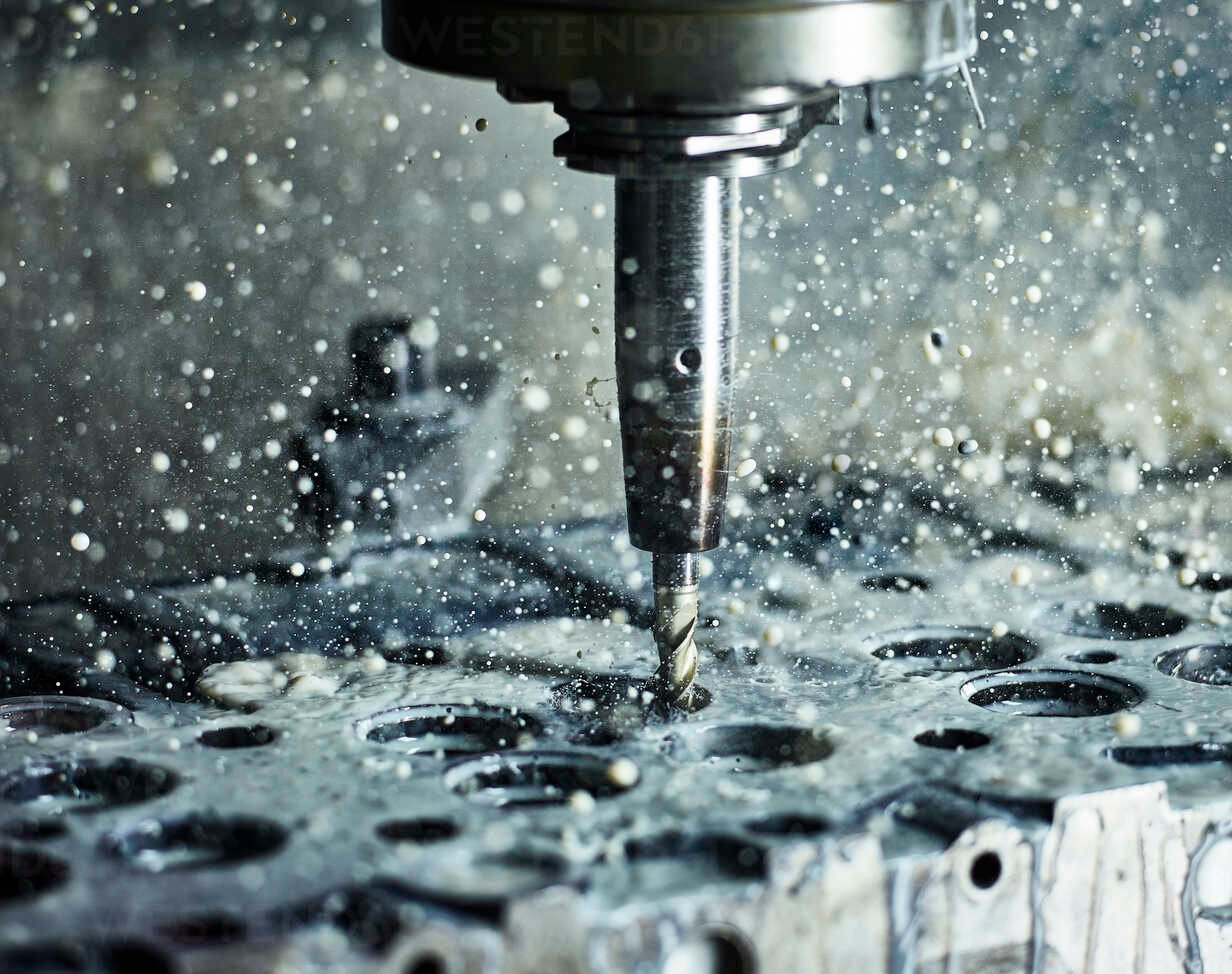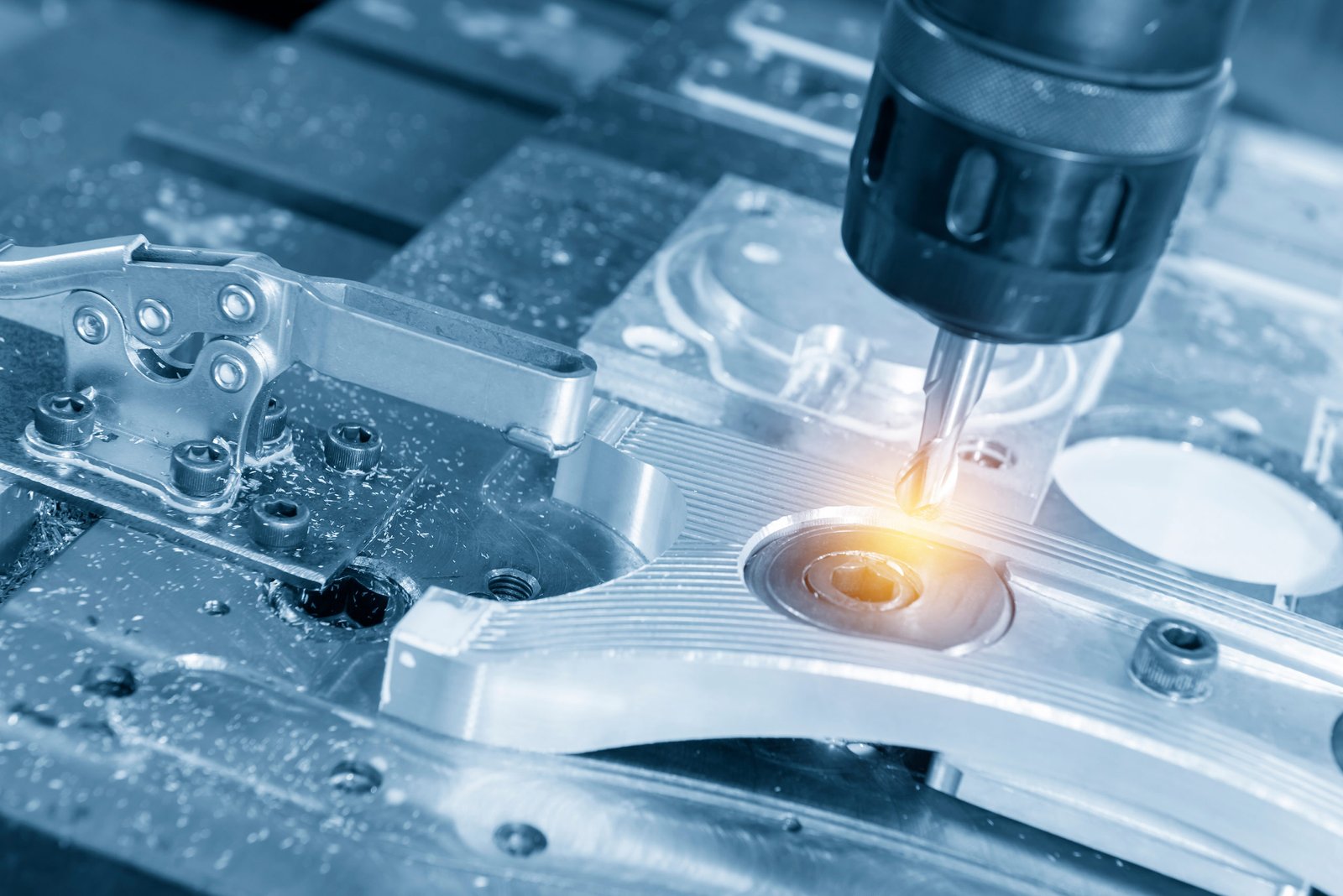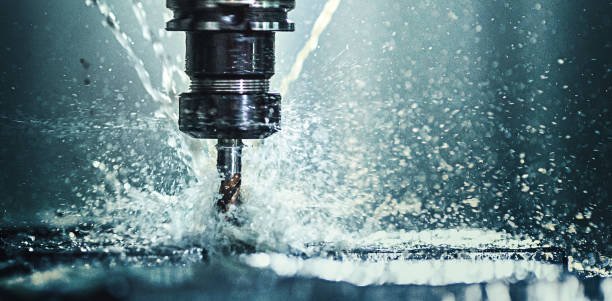The applications of CNC drilling span across diverse industries, each benefiting from its unique capabilities. Whether it’s crafting precision components for automotive engines or creating intricate patterns on architectural panels, CNC drilling has left an indelible mark on the manufacturing landscape.
Join us as we delve into the fascinating world of CNC drilling, exploring its inner workings and uncovering the myriad applications that make it indispensable in today’s industrial landscape.
What is CNC Drilling
CNC drilling, short for Computer Numerical Control drilling, epitomizes the marriage of technology and craftsmanship. At its core, it involves the use of computerized systems to automate and control the movement of drilling tools with pinpoint accuracy.
This method replaces traditional manual drilling processes, offering enhanced precision and repeatability while significantly reducing production time.

What Are the Advantages of CNC Drilling?
CNC drilling has transformed the manufacturing industry, offering unmatched precision, efficiency, and versatility. This advanced drilling method utilizes computer numerical control (CNC) to consistently achieve accurate and high-quality results. Here are the key advantages of CNC drilling:
- High Precision and Accuracy: CNC drilling machines can achieve exceptional levels of precision, typically within ±0.005 inches (±0.127 mm), ensuring each hole is drilled precisely as specified in the design.
- Efficiency and Speed: Compared to manual drilling, CNC drilling operations are significantly faster. Automation speeds up production, reducing turnaround times and boosting productivity.
- Versatility: CNC drilling machines can work with a wide range of materials, from metals to plastics and composites, making them suitable for various industries and applications. They can also accommodate different drill bit types and sizes, enhancing their versatility.
- Complex Drilling Patterns: CNC technology enables the execution of intricate drilling patterns that would be challenging or impossible to achieve manually. This capability opens up new design possibilities and manufacturing techniques.
- Reduced Waste: The accuracy of CNC drilling minimizes material waste, as each hole is drilled precisely according to specifications. This efficiency not only conserves materials but also lowers production costs.
- Operator Safety: CNC drilling reduces the need for direct manual intervention, thereby lowering the risk of injuries associated with manual drilling operations. Automation ensures a safer working environment for operators.
- Repeatability: CNC drilling can replicate the drilling process with exact precision, consistently producing identical parts. This repeatability is vital for mass production, ensuring uniformity across all manufactured components.
How CNC Drilling Operates
CNC drilling orchestrates the translation of a digital blueprint into a tangible component via a meticulously choreographed sequence, guaranteeing each bore aligns precisely with predefined specifications.
Initiating with design and planning, the journey of CNC drilling progresses through a succession of pivotal stages, each pivotal to the ultimate fruition:
Conceptualization and Planning
Inceptive deliberation encompasses envisioning the product and delineating drilling imperatives. This phase witnesses the metamorphosis of concepts into digital schematics, facilitated by CAD (Computer-Aided Design) software. Such tools furnish designers with the capacity to craft intricate 3D models, furnishing a blueprint for subsequent manufacturing processes.
CAD Modeling
Subsequent to preliminary deliberations, the ensuing step entails crafting a meticulous 3D rendition of the intended drillable component. CAD software emerges as a linchpin in this juncture, enabling precise modeling of the part, replete with requisite specifications.
Material Selection
The judicious selection of materials emerges as a linchpin for the efficacy of the drilling endeavor. Materials must not only align with the intended utility of the component but also comport with the exigencies of the drilling process.
Programming
This phase entails transmuting the CAD model into directives comprehensible to CNC machinery. CAM (Computer-Aided Manufacturing) software is harnessed to craft these directives, subsequently transmuted into G-code, the lingua franca of CNC machinery.
G-Code Generation
The culmination of the programming stage yields G-code, encapsulating directives for CNC machinery. These directives encompass the trajectory of the drill bit, drilling velocity, and depth of each bore.
Setup
Antecedent to drilling commencement, meticulous setup is imperative. This entails affixing the drill bit, securing the workpiece, and calibrating the machinery to ensure precision.
Drilling
The nucleus of the process unfolds as the machinery executes the G-code, boring holes into the workpiece. This phase may encompass diverse drilling cycles contingent upon exigencies:
- G73 (Chip Breaking Cycle): Tailored for profound bores, forestalling chip accumulation.
- G81 (Shallow Hole Circulation): Deployed for superficial bores, ensnaring pristine and precise drilling.
- G83 (Deep Hole Circulation): Tailored for exceedingly deep bores, integrating a pecking motion to expunge chips.
Monitoring and Adjustment
Vigilant monitoring throughout the drilling process is indispensable to validate adherence to predefined parameters. Adjustments may be requisite to reconcile any deviations.
Post-Processing
Subsequent to drilling, supplementary processing may be mandated, encompassing deburring to eliminate jagged edges and finishing operations to attain desired surface textures.
Quality Control and Inspection
The denouement entails scrutinizing drilled components to validate conformity to predefined specifications. This encompasses scrutinizing dimensions, surface finish, and overall bore quality.

What Kinds of CNC Drilling Operations Are There?
Spot Drilling
Spot drilling is the initial step in many CNC drilling processes, creating a guide for subsequent drilling operations by making a small indentation on the workpiece’s surface.
This ensures accurate positioning of drill bits for the main drilling operation, crucial for preventing drill bit wander and ensuring hole location accuracy, particularly in precision machining.
Drilling
At the core of CNC drilling operations lies drilling itself, the process of creating cylindrical holes in a workpiece using a rotating drill bit. This versatile operation can be performed on various materials, including metals, plastics, and composites, with precision and efficiency. It allows for a range of hole sizes and depths, adaptable to the specific requirements of each project.
Reaming
Reaming is a finishing operation that enhances the accuracy and smoothness of pre-drilled holes. By utilizing a reamer, a tool designed for this purpose, CNC machines achieve tight tolerances and high-quality surface finishes.
This operation is often necessary in applications requiring precise hole diameters and smooth internal surfaces, common in industries like aerospace and automotive manufacturing.
Boring
Boring extends the capabilities of drilling by enlarging an existing hole to a specific diameter with enhanced accuracy. This CNC drilling operation is essential for applications demanding precise hole diameters that cannot be achieved through standard drilling processes.
Precision hole size customisation is made possible by boring, meeting specific production requirements..
Counterboring
Counterboring creates a stepped hole where the larger diameter is at the surface, allowing the head of a bolt or screw to sit flush with or below the workpiece’s surface. This operation is crucial in many assembly processes, ensuring that fasteners do not protrude undesirably, which is particularly important in applications where aerodynamics or aesthetics are a concern.
Countersinking
Similar to counterboring, countersinking creates a conical hole that enables screw heads to sit flush with the workpiece’s surface. Widely used in applications requiring a smooth, flat surface, such as in the assembly of mechanical components, countersinking enhances both functional and aesthetic qualities, ensuring seamless integration of fasteners.
Tapping
Tapping is a CNC drilling operation that creates internal threads within a pre-drilled hole, allowing for the insertion of bolts or screws. This process demands precise control over the drill’s rotation and depth to ensure perfectly formed threads for the intended fastener.
Critical in assembly processes where components need secure fastening, tapping is a staple in manufacturing sectors like automotive and construction.
Micro-Drilling
Micro-drilling involves creating extremely small holes, often measured in micrometers, using specialized CNC machines equipped with fine drill bits.
Necessary for uses where accuracy is critical, such circuit board manufacturing in the electronics sector manufacturing or in medical device production, micro-drilling enables the development of intricate components with high precision.
Center Drilling
Center drilling serves as a preparatory operation for subsequent drilling or machining processes by creating a conical hole that guides the drill bit during deeper drilling operations, ensuring alignment and accuracy. Particularly important for long or complex drilling tasks, center drilling is foundational in achieving the high precision required in industries like aerospace and machinery manufacturing.
Peck Drilling
Peck drilling enhances chip evacuation and coolant flow during deep hole drilling operations by periodically retracting the drill bit. This breaks up and removes chips from the hole, reducing the risk of chip clogging and heat buildup, especially in materials prone to chip packing or when drilling to significant depths. Peck drilling is indispensable in producing components requiring deep, clean holes without thermal damage.
Gun Drilling
Gun drilling is a specialized CNC drilling operation for creating deep, straight holes with high precision, originating from the manufacture of gun barrels. To maintain accuracy and surface polish at longer depths, this approach makes use of a long, thin drill bit with internal cooling channels.
Vital in applications including hydraulic systems, aeronautical parts, and medical equipment that need exact deep holes.
Vibratory Drilling
Vibratory drilling incorporates vibration into the drilling process to improve cutting conditions and tool life. By oscillating the drill bit at a specific frequency, material removal rates are optimized, reducing the likelihood of drill bit failure.
Particularly effective in difficult-to-machine materials, vibratory drilling offers enhanced productivity and quality in specialized manufacturing processes.

What Materials Can CNC Drilling Handle?
Here’s an overview of the main material types suitable for CNC drilling:
- Metals: This category encompasses aluminum, steel, stainless steel, brass, copper, and titanium. Metals are popular in manufacturing due to their robustness and durability. CNC drilling can accurately create holes in these materials for various applications.
- Plastics: This category includes acrylic, polycarbonate, ABS (Acrylonitrile Butadiene Styrene), nylon (polyamide), PVC (Polyvinyl Chloride), and PTFE (Polytetrafluoroethylene, also known as Teflon). Plastics offer versatility and find use in applications requiring lightweight and corrosion resistance.
- Composites: Materials like carbon fiber reinforced polymers (CFRP) and fiberglass fall under this category. Composites combine materials to achieve specific properties such as increased strength or reduced weight and are prevalent in advanced applications like aerospace and automotive parts.
- Wood: This category comprises hardwood (e.g., oak, maple), softwood (e.g., pine, cedar), plywood, and MDF (Medium Density Fiberboard). Wood is widely utilized in furniture manufacturing, construction, and decorative applications.
It’s important to note that each material necessitates specific drill bit types and drilling parameters to achieve optimal results. Thus, selecting the right tools and settings for each drilling project is paramount.
>>> Read more: Vietnam CNC Machining Shop: A Comprehensive Overview
What Are the Applications of CNC Drilling?
CNC drilling plays a vital role in modern manufacturing, providing precision and efficiency unmatched by manual processes. Its applications span various industries, each with unique requirements and challenges. Let’s explore how CNC drilling is applied in key sectors.
Aerospace Industry
In the aerospace sector, CNC drilling is utilized to create precise holes in aircraft components. These holes are essential for fastening parts together, routing cables, and managing airflow.
Materials such as aluminum, titanium, and composites are commonly drilled, demanding high precision to meet rigorous safety and performance standards.
Automotive Industry
Integral to automotive manufacturing, CNC drilling is used for producing engine parts, chassis components, and other vehicle parts. It ensures accurate hole creation for bolts, screws, and other fasteners, contributing to the assembly of reliable and durable vehicles.
Manufacturing and Machinery
This expansive sector relies on CNC drilling for producing machinery parts, tools, and equipment. CNC drilling guarantees components fit together seamlessly, maintaining the integrity and functionality of the final product. It is used in creating parts for everything from industrial machines to household appliances.
Electronics and Semiconductor Industry
CNC drilling is employed in creating precise holes in circuit boards and electronic enclosures, crucial for mounting components, enhancing cooling, and ensuring electrical connections. Miniaturized electrical gadgets especially benefit from the capacity to drill precise, microscopic holes.
Medical Industry
In medical manufacturing, CNC drilling is utilized for producing surgical instruments, implants, and equipment. Because medical equipment needs to be extremely clean and precise, CNC drilling is essential for producing intricate parts with precise tolerances.
Construction and Architecture
By producing parts for structures like buildings, bridges, and infrastructure projects, CNC drilling helps the construction and architectural industries a lot. It enables precise drilling of structural elements, ensuring strength and stability in construction projects.
Energy Sector
The energy sector, including oil and gas, wind power, and nuclear energy, utilizes CNC drilling for manufacturing components like turbines, piping, and structural frames. For energy production and distribution networks to operate safely and effectively, precision drilling is essential.
Furniture Manufacturing
Extensively used in furniture manufacturing, CNC drilling creates holes for fasteners, dowels, and hardware. It facilitates the production of complex, high-quality furniture with consistent results.

Conclusion
CNC drilling has emerged as a cornerstone of modern manufacturing, offering unparalleled precision, efficiency, and versatility.
From aerospace and automotive industries to electronics, medical, and construction sectors, CNC drilling finds application across a wide array of industries, meeting diverse manufacturing needs with its ability to handle various materials and execute complex drilling patterns. As industries continue to advance, the demand for CNC drilling solutions is expected to grow further.
For businesses seeking reliable CNC drilling services in Vietnam, MaTec Vietnam stands as a trusted partner.
With its expertise, state-of-the-art equipment, and commitment to quality, MaTec Vietnam provides comprehensive CNC drilling solutions tailored to meet the unique requirements of each project. Contact MaTec Vietnam today to explore how their CNC drilling services can elevate your manufacturing processes and bring your projects to fruition.
